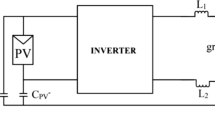Abstract
Transformerless inverters are prone to irregular voltage profiles, high harmonics and isolation problems while operating with photovoltaic systems and varying load conditions under stand-alone mode. The aim of the paper is to identify the drawbacks of transformerless inverters operating in stand-alone mode and to propose a new topology with improved performance and control. Further, an intelligent controller is designed to operate the proposed topology with various loads and varying load conditions. The developed controller achieves voltage regulation and low total harmonic distortion for the proposed topology when simulated under MATLAB/Simulink environment. Further, a laboratory prototype of the proposed inverter operating under stand-alone photovoltaic application is developed and operated with the developed control method. The proposed topology along with the developed controller achieves output voltage regulation and reduced THD under varying load conditions. The THD of the proposed system while operating with constant load is observed to be 1.8%, and for varying load condition, it is around 2.12%. Further, the efficiency and power loss of the system are calculated, and it is observed the system exhibits 98.5% efficiency. The achieved results are better when compared with existing work.





















Similar content being viewed by others
References
Patrao GGI, Figueres E, González-Espín F (2011) Transformerless topologies for grid-connected single-phase photovoltaic inverters. Renew Sustain Energy Rev 15(7):3423–3431
Islam M, Mekhilef S, Hasan M (2015) Single phase transformerless inverter topologies for grid-tied photovoltaic system: a review. Renew Sustain Energy Rev 45:69–86
Khan MA, Haque A, Kurukuru VSB, Mekhilef S (2021) Single phase transformerless photovoltaic inverter for grid connected systems—an overview. Int J Power Electron 12(1):1
Victor M et al (2005) US Patent Application-H5 Inverter (SMA), 0286281 A1
Saridakis S, Koutroulis E, Blaabjerg F (2013) Optimal design of modern transformerless pv inverter topologies. IEEE Trans Energy Convers 28(2):394–404
Islam M, Mekhilef S (2015) H6-type transformerless single-phase inverter for grid-tied photovoltaic system. IET Power Electron 8(4):636–644
Orfanoudakis GI, Sharkh SM (2017) Single-phase transformerless PV inverter topology with AC bypass and mid-DC-link voltage clamping. In: 2017 19th European conference on power electronics and applications, pp 1–10
Khan MA, Haque A, Kurukuru VSB (2020) Performance assessment of stand-alone transformerless inverters. Int Trans Electr Energy Syst 30(1):e12156. https://doi.org/10.1002/2050-7038.12156
Chaibi Y, Salhi M, El-jouni A (2019) Sliding mode controllers for standalone PV systems: modeling and approach of control. Int J Photoenergy 2019:5092078. https://doi.org/10.1155/2019/5092078
Levant A (2007) Principles of 2-sliding mode design. Automatica 43(4):576–586
Parvez M, Elias MFM, Rahim NA (2018) Analysis of current harmonics compensation and the effect of frequency variation for single-phase stand-alone PV inverters using PR controller. IETE J Res 64(4):463–470
Lidozzi A, Ji C, Solero L, Zanchetta P, Crescimbini F (2015) Resonant–repetitive combined control for stand-alone power supply units. IEEE Trans Ind Appl 51(6):4653–4663
Adda R, Ray O, Mishra SK, Joshi A (2013) Synchronous-reference-frame-based control of switched boost inverter for standalone DC nanogrid applications. IEEE Trans Power Electron 28(3):1219–1233
Somkun S (2019) Unbalanced synchronous reference frame control of singe-phase stand-alone inverter. Int J Electr Power Energy Syst 107:332–343
Sukumar Z, Ahteshamul M (2015) Performance evaluation of modified perturb & observe maximum power point tracker for solar PV system. Int J Syst Assur Eng Manag 7(1):229–238
Haque A (2014) Maximum power point tracking (MPPT) scheme for solar photovoltaic system. Energy Technol Policy 1(1):115–122
Zeb K et al (2018) A review on recent advances and future trends of transformerless inverter structures for single-phase grid-connected photovoltaic systems. Energies 11(8):1968
Moin P (2012) Numerical differentiation—finite differences. Fundam Eng Numer Anal 0160:13–29
Jang J-SR (1993) ANFIS: adaptive-network-based fuzzy inference system. IEEE Trans Syst Man Cybern 23(3):665–685
National electrical code (2011)
Markiewicz H, Klajn A (2004) Power quality application guide-voltage disturbances Standard EN 50160. Copp Dev Assoc, vol 5.4.2, pp 4–11
IEEE Guide for Maintenance Methods on Energized Power Lines. IEEE Std 516-2003 (Revision IEEE Std 516-1995) (2003)
Cha H, Vu T-K (2010) Comparative analysis of low-pass output filter for single-phase grid-connected Photovoltaic inverter. In: Applied Power electronics conference and exposition (APEC), pp 1659–1665
Liserre M, Blaabjerg F, Hansen S (2005) Design and control of an LCL-filter-based three phase active rectifier. IEEE Trans Ind Appl 41(5):1281–1291
Sosa JM, Escobar G, Martinez-Rodriguez PR, Vazquez G, Juarez MA, Diosdado M (2014) Comparative evaluation of L and LCL filters in transformerless grid tied converters for active power injection. In: Power, electronics and computing (ROPEC)
Bhardwaj M, Choudhury S, Xue V, Akin B (2014) Online LCL filter compensation using embedded FRA. In: Applied power electronics conference and exposition (APEC), pp 3186–3191
Zong X (2011) A single phase grid connected DC/AC inverter with reactive power control for residential PV application
Lakkas G (2016) MOSFET power losses and how they affect power-supply efficiency. Analog Appl J 10:42–44
Maniktala S (2012) Switching power supplies A-Z. Elsevier, Amsterdam
Liu Y-C, Chen M-C, Yang C-Y, Kim K, Chiu H-J (2018) High-efficiency isolated photovoltaic microinverter using wide-band gap switches for standalone and grid-tied applications. Energies 11(3):569
Duan RY, Chang CT (2008) A novel high-efficiency inverter for stand-alone and grid-connected systems. In: 2008 3rd IEEE conference on industrial electronics and applications. ICIEA 2008, pp 557–562
Debnath D, Chatterjee K (2016) Solar photovoltaic-based stand-alone scheme incorporating a new boost inverter. IET Power Electron 9(4):621–630
Kumar N, Saha TK, Dey J (2019) Multilevel inverter (MLI)-based stand-alone photovoltaic system: modeling, analysis, and control. IEEE Syst J. https://doi.org/10.1109/JSYST.2019.2900485
Acknowledgements
The experiment is done in Advance Power Electronics Research Lab, Dept. of Electrical Engg, developed from R&D Grant received from Ministry of New and Renewable Energy, Govt of India.
Author information
Authors and Affiliations
Corresponding author
Additional information
Publisher's Note
Springer Nature remains neutral with regard to jurisdictional claims in published maps and institutional affiliations.
Rights and permissions
About this article
Cite this article
Khan, M.A., Haque, A. & Kurukuru, V.S.B. Intelligent control of a novel transformerless inverter topology for photovoltaic applications. Electr Eng 102, 627–641 (2020). https://doi.org/10.1007/s00202-019-00899-2
Received:
Accepted:
Published:
Issue Date:
DOI: https://doi.org/10.1007/s00202-019-00899-2




